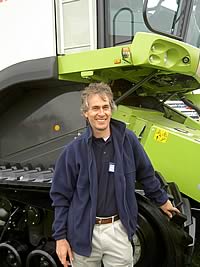 |
|||||||||
|
|||||||||||||||||||
| Managing The Harvest Is Key To Linseed Success 15/07/05
"Timely and efficient desiccation with careful combining are vital to seed yields as well as early and easy harvesting," insisted company technical director, Andrew Probert, publishing a practical guide to both operations this week (July 15). "With more than double the area of linseed in the ground this year and at least 50% of those producing the crop not regular linseed growers, the margin for error in harvesting and desiccation is higher than ever. "Linseed can be combined rapidly and efficiently immediately after the wheat harvest for a good, timely first wheat entry," he pointed out. "But both desiccation and harvesting need to be spot-on." Glyphosate is Premium Crops' first choice desiccant to even-up ripening and provide valuable stubble cleaning, with modern Roundup formulations giving significantly better results than traditional 360s. The company stresses, though, that correct spray timing is essential. "The seeds need to be full-sized, plump and ivory in colour, with the pods yellowy-lime green, the upper stems and leaves still green/yellow and the lower leaves withered," explained Andrew Probert. "If you spray earlier than this, while the seeds are white to light green and their moisture content is too high, you risk seed shrivelling and serious yield losses. Equally, if you don't spray until the seeds are dark brown and stems yellow and leafless the glyphosate will be largely ineffective." Timely harvesting is equally important in Andrew Probert's experience. Although linseed can be combined 14 days after Roundup spraying, he notes that 21-28 days may be necessary for complete desiccation, depending on the weather. "Just like rape and wheat, the key is to harvest linseed when the crop is ready," he observed. "In this case, that's when the seeds can be separated easily from the pods by hand and the moisture content is in the 8-12% range. It may be that the straw is still slightly green at this stage, but most modern combines will handle green stems with little problem. Combining before complete desiccation can lead to thrashing problems. However while linseed doesn't shed easily, leaving it too long can cause over-retting in the stems, making cutting very difficult. "Correct combine setting is also important in ensuring an efficient and trouble-free harvest," Andrew Probert added. "As is the right combining technique." Copies of the Premium Crops Linseed Desiccation and Combining Guide giving practical information born of extensive field experience are available free of charge from the company by phoning 02392 632883. |
|||||||||||||||||||

|
|
||||||||||||||||||
| home | agri-services | pedigree
pen | news | dairy | beef | machinery BPS | property | organisations | site map |
|||||||||||||||||||
